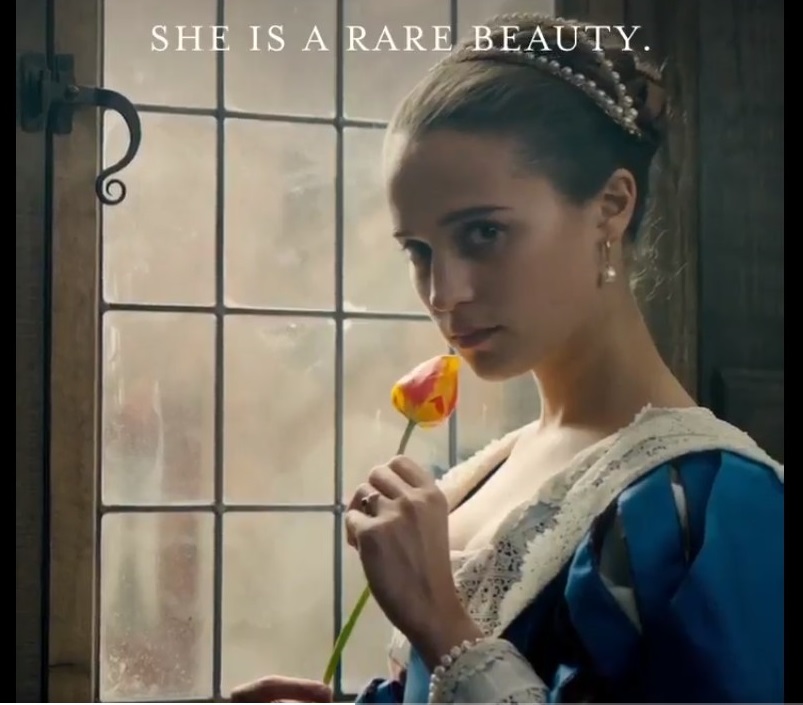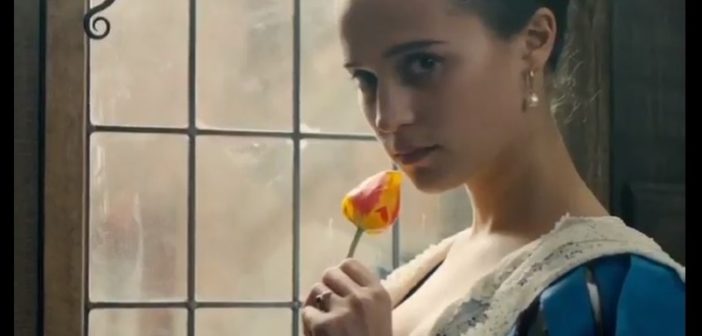
@TulipFeverFilm
“Tulip Fever” stars Alicia Vikander (The Danish Girl,) Dane DeHaan (The Amazing Spiderman 2,) Jack O’Connell (Money Monster,) Zack Galifianakis (The Hangover Trilogy,) Judi Dench (James Bond Films,) Christoph Waltz (Spectre,) Holiday Grainger (2015 Cinderella remake,) Matthew Morrison (Glee,) and Cara Delevingne (Suicide Squad).
The film is an adaptation of the best-selling novel of the same name by Deborah Moggach, directed by Justin Chadwick (Mandela: Long Walk to Freedom) and was written by Tom Stoppard (Shakespeare in Love).
“Tulip Fever” takes place in the seventeenth century, circa 1635 at the height of the thriving Tulip trade. Before the regulation by the Dutch government, Tulip Bulbs were traded in the open market, and an obscene amount of money paid for the rarest of them all. The general aesthetic of the movie is particularly overwhelming.
The set, although small and refined, was built with immaculate details. Cinematography complimented this well, with a dampening of general objects and an oversaturation of elements that warranted more attention. Throughout the movie, a blue cloak was more vibrant than the sky, or a white tulip appeared even brighter in contrast to the clouds in the sky. With that said, the general aesthetic of the period was captured in detail and artistically relayed.
The characters while on the screen will hold your attention as their dynamics are intriguing and lure you with their commitment to character. Dench’s character is introduced early on but becomes an epicenter of sorts for the film’s direction. Vikander and Waltz noticeably as the husband and wife show chemistry throughout. Sophia (Vikander) struggles with being young, married and deeply troubled while Waltz struggles with his own demons of finding self-worth and creating a legacy.
“Tulip Fever” is held together by an incredible ensemble of supporting cast who often are not utilized well for their prominence and acting range. One of whom is David Harewood (Martian Manhunter- Supergirl TV Series 2015- present,) his character, Prater trades Tulips and Bulbs on the open market, and the underutilization of his range is apparent, as he sometimes delivers bland lines. The plot, which fails to connect the characters faster, uniting them under one centralized them attributes to that.
Character arcs are either not fully revealed or fall flat quite often, due in part to the fact that there was a lot that needed to be done with the script. There was so much ground to cover between establishing lines of dialogue between multiple characters and building tension that more was desired of each character.
The plot is strong as the themes of sacrifice, love, betrayal, and revenge are not forced on viewers but develop naturally. The transitions from scene to scene lag at times but succeed in
bringing tension to the screen. When Sophia and DeHaan’s characters move closer together, the tension builds to an untenable head. Glances across the room, hands brushing against each other, and the perpetual stare of DeHaan’s eyes foster a pure energy on screen that allows viewers to become even more invested in finding resolve. As the movie continues, it falls flat on delivering that resolve by adding additional subplots cutting into runtime and destroying the built-up tension.
As moviegoers are often suckers for happy endings, we look to have most, if not all questions answered with some degree at the end. As the plot ends, viewers are left with more questions and a general sense of betrayal, as the main character arc of the husband (Cornelus Sandvoort) is inaccurate from the previews suggest.
While there is nothing wrong with not spilling every detail of a movie in the preview, many movies can be watched in their theatrical four-minute trailers. “Tulip Fever” takes an entirely different direction which destroys the plot and its motivation.
“Tulip Fever,” as mentioned before is a stunning and cinematographic masterpiece. The landscape is shot beautifully, and much respect is paid to the era as the set is immaculate. Costume designs were flawless and lent great credibility to the era. The main cast, as well as the supporting cast, were about twelve strong, however, they were underutilized for their capabilities.
Something of distinct beauty occurs as Vikander and DiHaan take center stage; however, it is bogged down by a script that is possibly too condensed from the source material. The plot given in the preview is contradicted in a very subtle way near the final act, which is slightly disrespectful It pulls a rug from under viewers and causes the question to arise, “Why not try an easier way?”
The historical references coupled with the imagery that the director plays with, as he adjusts images in the background and foreground made historians drool. However, there was a general sense of betrayal as viewers were entreated to continue believing in a plot that was not supported in the script.
In researching the film, it was originally shot in 2014 with a 2015 release date slated. However, due to many issues notwithstanding reshoots, cuts and stalls to bait Academy Awards, the project has fallen flat. When juxtaposed against a 24-million-dollar budget and an underperforming 1.2-million-dollar weekend release, it is easy to understand how the public feels about the movie. “Tulip Fever” is good time waster during a hurricane but lacks anything of substance that warrants watching in theaters. Overall, 2 and a half paws out of 5.





